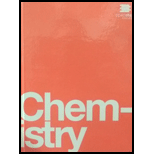
Concept explainers
The light produced by a red neon sign is due to the emission of light by excited neon atoms. Qualitatively describe the spectrum produced by passing light from a neon lamp through a prism.
Interpretation:
The spectrum produced by passing light from a neon lamp through a prism is to be explained.
Concept introduction:
The distance between consecutive troughs or peaksis said to be the wavelength of any wave and is denoted by λ. The unit of wavelength is meter, cm, nm, mm etc.
The reciprocal of wavelength of any wave is called wave number. It is denoted by
Frequency of any wave is the number of oscillations per second means the number of oscillation in one second. It is denoted by ν. The unit of frequency is per second. Its SI unit is Hz , which is equal to
The energy of a photon is calculated by the Plank’s equation. The equation is following:
Here,
Spectrum:
The special wavelength of electro-magnetic radiation, which is emitted or absorbed by an object like substance, atom or molecules is known as a spectrum.
Spectrum is mainly two types:
- Emission spectrum
- Absorption spectrum
Answer to Problem 1E
The spectrum produced by passing light from a neon lamp through a prism is line spectrum.
Explanation of Solution
When the radiation is emitted from any substance, it is called emission spectrum.
In the type of emission spectrum, light or electro-magnetic radiation directly passed through a prism.
It is mainly divided into three types as follows:
- Continuous spectrum
- Line spectrum
- Band spectrum
The spectra produced from neon is an example of line spectrum, in which spectrum consists of discrete lines corresponding to the wavelength of the colour emitted by the substance. When the radiation which is produced from neon passed through a prism there are multiple lines of brightness of red colour, which indicate it is a line (emission) spectrum.
Want to see more full solutions like this?
Chapter 6 Solutions
Chemistry by OpenStax (2015-05-04)
Additional Science Textbook Solutions
College Physics
Chemistry: Structure and Properties (2nd Edition)
Essential Organic Chemistry (3rd Edition)
General Chemistry: Principles and Modern Applications (11th Edition)
Chemistry: The Central Science (14th Edition)
Introductory Chemistry (6th Edition)
- When a tube containing hydrogen atoms is energized by passing several thousand volts of electricity into the tube, the hydrogen emits light than when passed through a prism, resolves into the "bright line" spectrum shown in Fig. 11.10. Why do hydrogen atoms emit bright lines of specific wavelengths rather than a continuous spectrum?arrow_forwardOzone in the stratosphere absorbs ultraviolet light of wavelengths shorter than 320 nm, thus filtering out the most energetic radiation from sunlight. During this absorption, an ozone molecule absorbs a photon, which breaks an oxygen-oxygen bond, yielding an oxygen molecule and an oxygen atom: O3(g)+hvO2(g)+O(g) (Here, hv denotes a photon.) Suppose a flask of ozone is irradiated with a pulse of UV light of wavelength 275 nm. Assuming that each photon of this pulse that is absorbed breaks up one ozone molecule, calculate the energy absorbed per mole of O2 produced, giving the answer in kJ/mol.arrow_forwardTraffic signals are often now made of LEDs (light-emitting diodes). Amber and green ones are pictured here. (a) The light from an amber signal has a wave-length of 595 nm, and that from a green signal has a wavelength of 500 nm. Which has the higher frequency? (b) Calculate the frequency of amber light.arrow_forward
- Give a brief wave description of light. What are two characteristics of light waves?arrow_forwardConsider only the transitions involving the first four energy levels for a hydrogen atom: a. How many emissions are possible for an electron in the n = 4 level as it goes to the ground state? b. Which electronic transition is the lowest energy? c. Which electronic transition corresponds to the shortest wavelength emission?arrow_forwardArrange the kinds of light listed below in order of increasing wavelength: Red visible light, blue visible light, infrared light, and X-rays X-ray blue visible red visible infrared infrared red visible blue visible X-ray blue visible red visible X-ray infraredarrow_forward
 Chemistry by OpenStax (2015-05-04)ChemistryISBN:9781938168390Author:Klaus Theopold, Richard H Langley, Paul Flowers, William R. Robinson, Mark BlaserPublisher:OpenStax
Chemistry by OpenStax (2015-05-04)ChemistryISBN:9781938168390Author:Klaus Theopold, Richard H Langley, Paul Flowers, William R. Robinson, Mark BlaserPublisher:OpenStax Chemistry: Principles and PracticeChemistryISBN:9780534420123Author:Daniel L. Reger, Scott R. Goode, David W. Ball, Edward MercerPublisher:Cengage Learning
Chemistry: Principles and PracticeChemistryISBN:9780534420123Author:Daniel L. Reger, Scott R. Goode, David W. Ball, Edward MercerPublisher:Cengage Learning General Chemistry - Standalone book (MindTap Cour...ChemistryISBN:9781305580343Author:Steven D. Gammon, Ebbing, Darrell Ebbing, Steven D., Darrell; Gammon, Darrell Ebbing; Steven D. Gammon, Darrell D.; Gammon, Ebbing; Steven D. Gammon; DarrellPublisher:Cengage Learning
General Chemistry - Standalone book (MindTap Cour...ChemistryISBN:9781305580343Author:Steven D. Gammon, Ebbing, Darrell Ebbing, Steven D., Darrell; Gammon, Darrell Ebbing; Steven D. Gammon, Darrell D.; Gammon, Ebbing; Steven D. Gammon; DarrellPublisher:Cengage Learning
 ChemistryChemistryISBN:9781305957404Author:Steven S. Zumdahl, Susan A. Zumdahl, Donald J. DeCostePublisher:Cengage Learning
ChemistryChemistryISBN:9781305957404Author:Steven S. Zumdahl, Susan A. Zumdahl, Donald J. DeCostePublisher:Cengage Learning Introductory Chemistry: A FoundationChemistryISBN:9781337399425Author:Steven S. Zumdahl, Donald J. DeCostePublisher:Cengage Learning
Introductory Chemistry: A FoundationChemistryISBN:9781337399425Author:Steven S. Zumdahl, Donald J. DeCostePublisher:Cengage Learning





